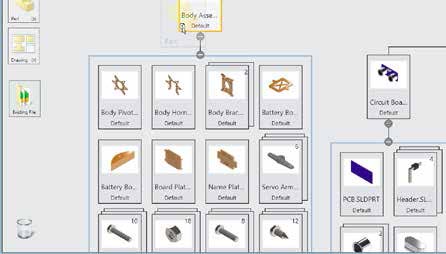Dassault Systèmes offers its retail community a change in leadership, new products, and assurances of continuity. No one said being number one was going to be easy.
By Kathleen Maher and L. Stephen Wolfe

This year, the annual SolidWorks World was the site of a transition in the C-Suite as CEO Bertrand Sicot ascends to the Dassault mother ship where he will head the company’s reseller organization for Catia, Enovia, Delmia and other higher-priced engineering software products. Taking his place is the genial Gian Paolo Bassi, who headed the Solid Works development team. Sicot took the stage and told attendees that for the next three days he could be found in the bar. More accurately, he was showing up in lots of bars as he made the rounds to say goodbye and support Bassi.
During his tenure, Sicot began several major transitions for SolidWorks. Dassault has said that they’d like to get all their products using the same technology including the underlying graphics engine. Dassault’s Catia products are based on Dassault’s CGM kernel while SolidWorks is built on Siemens’ Parasolid kernel. In reality, the company can’t really make major changes to the SolidWorks graphics engine without creating a huge and inconvenient shift for SolidWorks customers.

So instead the company is introducing new applications based on CGM and what Dassault Systèmes calls the “3D Experience Platform” that work alongside SolidWorks and extend its capabilities. The first module was Mechanical Conceptual introduced last year to simplify the initial design of mechanical mechanisms and assemblies. This year, just to keep it confusing, the company has renamed Mechanical Conceptual to Conceptual Design and has introduced two new products: Industrial Design and Treehouse.
Industrial Design, like Conceptual Design, is based on the 3D Experience Platform (formerly called Catia/Enovia V6). It employs no files. Instead it stores models in a database on a computer array accessible via the Internet (popularly called “the cloud.”) Industrial design is intended for makers of stylish products ranging from kitchen appliances to designer eyewear. Like Autodesk’s Fusion 360, Industrial Design employs subdivision surfaces that enable designers to push and pull on them to achieved designed shapes. Surfaces maintain curvature continuity (C2) automatically if the designer desires. Like Fusion 360, it also employs dimension-driven form features for tasks such as making thin shells, drilling holes, and cutting slots.

The reception of the new 3D Experience
Platform applications from the SolidWorks user base have been given a chilly reception because of pricing. The SW Conceptual Design product costs $2,998 per year and the new SolidWorks Industrial Design is $2,280. The prices are fluctuating as customers push back. The company says all the new products will be sold as monthly subscriptions. The users don’t mind subscription so much, but they do mind high-priced subscriptions.
Treehouse is a tool from SolidWorks Labs that has been around for a few years. It lets designers create the structure of an assembly before making any geometry. As products become more complex and involve more systems engineering, a tool like Treehouse becomes valuable to communicate the overall design strategy. For example, if one were designing a child’s wagon, the Treehouse model would contain placeholders for four wheels, two axles, the wagon box, a handle to pull it, etc. Then individual designers could go about designing each part or assembly to fit the overall structure.

Also adding on to the cloud capabilities, Dassault introduced My SolidWorks as a resource for the SolidWorks community to get additional information such as training, videos, to share parts, etc. At this year’s conference Dassault introduced a Professional version with higher quality content – more advanced training, more support, more models. etc. The goal for My SolidWorks is to create a repository of high quality information for users that keeps SolidWorks users at home instead of out there roaming on the web.
At this year’s conference two new products based on the original SolidWorks were announced: SolidWorks Inspection and Model Based Definition. The Model Based Definition tool works like a 3D PDF in that it allows dimensional annotation to be applied directly to a model using named views. This technique is defined by ANSI standard Y14.41 and its ISO equivalent. Dassault execs crowed Model Based Definition will eliminate the need for 2D drawings.
SolidWorks Inspection is a tool for people who are required to create inspection drawings and reports for inspecting parts as they are received at assembly plants. All the new SolidWorks CGM-based tools have a cloud-based element that lets users share designs, collaborate, and comment. SolidWorks has let it be known that many more of these modules are coming that will expand the capabilities of the core SolidWorks application.
The company has also made it clear it will continue to support and upgrade the original SolidWorks. This year, the company showed many new features that were part of their customers’ wish-lists. SolidWorks has reduced file sizes by 50% resulting in significant performance improvement as well as efficiency. Many other improvements were around patterning, flattening of cloth and sheet-metal models, changing scales of drawing views, and much more. The company has a list of improvements on its site.
Bassi told the audience, “we want to embrace the future,” because that’s what any company is required to do if they want to continue to exist, but he said, we want to respect the legacy. The SolidWorks users are going to be watching Bassi closely. So far, Dassault has kept its SolidWorks users loyal. Attendance at the show is higher than ever, reaching 5,500 and the company claims 2.8 million users – a number that includes educational licenses. Of that 2.8 million, SolidWorks says 2 million of them are educational users.
As he has been for several years, Dassault Systèmes CEO Bernard Charlés was onstage and complemented Sicot on his performance growing the SolidWorks community by two times in four years. In addition, SolidWorks’ partner network has grown 38% and the company has seen 50% revenue growth.
Now, says Charlés, Sicot has taken a billion dollar bet to grow the reseller channel based around the Catia business. Sicot believes the 3D Experience Platform offers opportunities for Catia, Enovia, and Delmia to expand in part by penetrating smaller companies that need sophisticated capabilities but have heretofore found the software too difficult to deploy.
What do we think?
Dassault is negotiating tricky territory. The company is revamping its high-end business and developing a tools and services industry that has as much in common with SAP and Salesforce as it does with Autodesk, PTC, or its own SolidWorks division. As a result, the company’s revenues are much more diversified and they’ve outpaced that of their competitors by a billion or so (but who’s counting).
The SolidWorks product competes with Autodesk’s Inventor, PTC’s Creo, Siemens’ Solid Edge and the competition is based on the tools. The high end where Catia lives is much more about process than tools. Dassault has fashioned the “3D Experience” which includes dashboards to information and market trends, visualization tools, simulation tools, design, product management and lifecycle management. The company is moving SolidWorks into that ecosystem.





